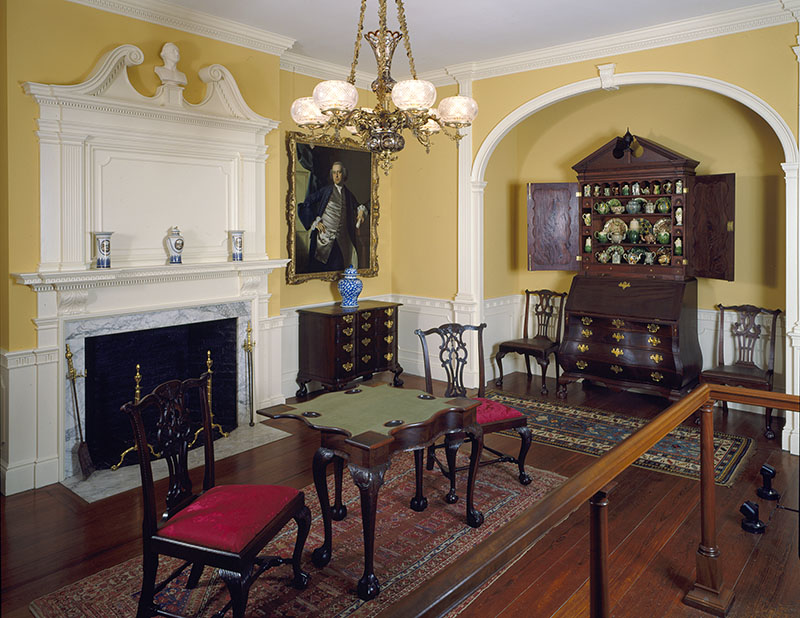The Importance of Being Furnished: Four Bachelors at Home
Click on images to enlarge them and view captions.
by R. Tripp Evans
During his successful American tour in 1882, Oscar Wilde assured “the youth of the land” that “the passion for beauty engendered by the decorative arts will be to them more satisfying than any political or religious enthusiasm, any enthusiasm for humanity, any ecstasy or sorrow for love.”1 Couched within his most popular lecture, “The House Beautiful,” Wilde’s pronouncement re-imagined the very purpose of the American home—from crucible of family life to laboratory of individual artistic expression. In tandem with this shift rose an equally novel development: the emergence of the bachelor household as an aspirational domestic model. As the popular Munsey’s magazine declared in 1899, “the bachelor… has become master of the comforts and luxuries of a home of his own, with all the resources of capital and science to minister to his every need.”2
This summer, Historic New England (HNE) invites visitors into the private world of four such “bachelor-aesthetes,” men who defined American style from the Gilded Age to the Jazz Age yet whose lives have remained, until now, mostly in shadow. The Importance of Being Furnished: Four Bachelors at Home, an exhibition at the historic Eustis Estate in Milton, MA, examines their foundational role in early-20th-century preservation, collecting, and interior design, showcasing an extraordinary range of furnishings and personal artifacts drawn from their homes.
The c. 1741 Codman Estate (figure 1) in Lincoln, MA, was home to five generations of Codmans and redecorated in its final stage by renowned designer, Ogden Codman Jr. (1863–1951). Gibson House (figure 2) in Boston’s Back Bay, is an 1860 townhouse preserved by its final occupant, writer Charles Hammond Gibson Jr. (1874–1954). The 1906 Pendleton House (figure 3) at the Rhode Island School of Design (RISD) Museum, was built to replicate the Federal-era home of collector Charles Leonard Pendleton (1846–1904). Beauport (figure 4) in Gloucester, MA, is the eclectic 1907 masterpiece of interior decorator Henry Davis Sleeper (1878–1934). Codman, Gibson, Pendleton, and Sleeper were the very men Wilde had in mind in 1882: acolytes of beauty whose collections, homes, and even whose very persons exemplified his decree that “the secret of life is in art.”3 Testifying to their significance, all four residences are now pubic museums.
Codman developed his successful decorating style by reconciling two seemingly disparate approaches: the Yankee restraint of his ancestral home and the Continental excess he embraced as an expatriate. Codifying this aesthetic in the authoritative 1897 treatise he co-authored with Edith Wharton, The Decoration of Houses, he became one of the greatest tastemakers of his age. Through a wide-ranging collection of furnishings, plans, and personal materials, the exhibition illuminates how the designer’s family home served as his first decorating laboratory—and how his patrician and rakish ancestors informed his signature style.
For Gibson, no beauty matched his own gilded youth and poetic voice, and so he arrested these forever in his family’s Back Bay home. Until his death in 1954, he faithfully preserved the interiors of 137 Beacon Street, last redecorated by his mother in the 1890s. He penned endless sonnets in a Victorian mode, and when he received visitors, he did so dressed like a Boston Brahmin of the late 19th century. Using letters, manuscripts, furnishings, and the home’s ubiquitous examples of Gibson’s own youthful image, the show reveals the man as a kind of historical manifestation of Wilde’s Dorian Gray.
In assembling his unparalleled collection of 18th-century furniture, Pendleton strove for visual perfection—even sometimes at the expense of the works’ authenticity. Exhibition visitors will see examples of his extraordinary collection alongside reproductions the dealer passed off as the genuine article. By recreating a tableau of Pendleton’s now-vanished private interiors, moreover, this exhibit considers their translation to the “period rooms,” a curatorial practice first introduced when RISD’s Pendleton House opened in 1906.
At Beauport, one of the most widely published houses in America, Sleeper orchestrated beauty in a surprising range of forms. Using color, line, scale, pattern, and visual humor, the designer disregarded historical accuracy to achieve powerful visual effects. Even those familiar with the house will see new juxtapositions in HNE’s exhibition, encountering important objects sometimes disguised within the house’s wonderfully distracting variety. Here, too, visitors will consider how Sleeper’s inner circle drove Beauport’s development—including collector Isabella Stewart Gardner, painter Cecilia Beaux, and the dashing financial scholar A. Piatt Andrew, Sleeper’s primary muse.
The Importance of Being Furnished: Four Bachelors at Home presents a unique opportunity to see the New England home in a new context, and through the lens of objects that have, in most cases, never left the interiors for which they were acquired. Together, this constellation of works illuminates an under-examined story in the history of American interior design, all within the walls of a historic home that is itself an important example of Aesthetic Movement design. Wilde himself could not have chosen a more appropriate venue.
- Oscar Wilde, Essays and Lectures (London: Methuen & Co. Ltd., 1913), 109.
- James L. Ford, “Luxurious Bachelordom,” Munsey’s Magazine 20 (March 1899): 584.
- Wilde, Essays and Lectures, 156.
Tripp Evans is a Professor of Art History at Wheaton College in Norton, MA. He is the author of The Importance of Being Furnished: Four Bachelors at Home (Rowman & Littlefield, 2024) and guest curator of the Historic New England exhibition of the same title at the Eustis Estate in Milton, MA, through October 27.
A print version of this article was published in The Magazine of the Decorative Arts Trust, one of our most popular member benefits. Join today!




